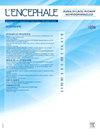[自闭症谱系障碍(ASD)儿童和青少年的疼痛评估:系统综述]。
IF 1.2
4区 医学
Q4 NEUROSCIENCES
Encephale-Revue De Psychiatrie Clinique Biologique et Therapeutique
Pub Date : 2025-02-01
DOI:10.1016/j.encep.2024.04.007
引用次数: 0
摘要
目的:患有自闭症谱系障碍的儿童和青少年由于其固有的沟通障碍,对疼痛的诊断仍然不足。本综述旨在确定最适合评估该人群疼痛的方法,以及评估对疼痛的具体感知或行为反应的方法,同时考虑到障碍的严重程度和具体情况(是否伴有智力障碍,是否伴有语言障碍):方法:对国际文献进行系统回顾和分析:结果:选取了 14 项研究。没有发现自闭症儿童或青少年的疼痛相关行为因年龄或性别而有差异。三项研究显示,自闭症谱系障碍儿童的疼痛相关行为与对照组相似。其他研究则显示,自闭症谱系障碍患者在急性疼痛发作时会有特殊的行为反应,生理和行为恢复时间较长。同样,三项侧重于疼痛感觉的研究均显示,自闭症谱系障碍人群与对照组相比存在差异。在医院或日常生活中,研究基本上都显示了特异性表达、过度警觉、运动性激动、负面情绪反应或发声。关于自闭症严重程度与对疼痛的低敏感性之间的关系,即使同时存在语言障碍或智力障碍(与自闭症同时存在),结果仍然不明确。非沟通型儿童疼痛核对表及其法文和意大利文译本显示出良好的内部有效性,几乎一半的研究在异质评估中使用了该核对表,其中大部分由家长使用。研究建议让家长参与评估,以优化评估过程。同样,对研究中家长/儿童/护理人员访谈的分析也强调了对儿童和青少年进行个性化疼痛评估的重要性,同时考虑到特定对象的特点、病理和背景:结论:综合和个性化的疼痛评估方法似乎最适合用于增强自闭症谱系障碍患者对疼痛的理解和检测。这种方法非常适合自闭症患者的护理环境,在这种环境中,由指定的具有自闭症专业知识的专业人员负责疼痛评估。鉴于识别自闭症患者疼痛的复杂性,我们认为有必要结合新的疼痛检测技术开展进一步的定性研究,并对人群进行更广泛的分类研究。本文章由计算机程序翻译,如有差异,请以英文原文为准。
Évaluation de la douleur des enfants et adolescents avec troubles du spectre de l’autisme : une revue systématique
Objective
Pain in children and adolescents with autism spectrum disorders remains underdiagnosed due to their inherent communication difficulties. The goal of this review is to identify the most suitable methods for assessing pain in this population and for evaluating the specific perceptions of, or behavioural reactions to, pain whilst considering disorder severity and specifiers (with or without accompanying intellectual impairment, with or without accompanying language impairment).
Method
A systematic review and analysis of the international literature was conducted.
Results
Fourteen studies were selected. No difference was found in pain-related behaviours based on the age or gender of children or adolescents with autism. Three studies showed pain-related behaviours in autism spectrum disorders to be similar to control groups. Other studies showed specific behavioural responses in autism spectrum disorders with a longer physiological and behavioural recovery time associated with an episode of acute pain in this population. Similarly, the three studies that focused on sensory perceptions of pain all showed differences in the autism spectrum disorders population compared to control groups. In hospital or daily life contexts, studies essentially showed idiosyncratic expressions, hypervigilance, motor agitation, negative emotional reactions, or vocalizations. Regarding the association of autism severity with hyposensitivity to pain, the results remain unclear even when language disorders or intellectual disabilities are also present (in conjunction with autism). The Non-Communicative Children Pain Checklist and its translation into French and Italian showed good internal validity and was used by almost half of the studies in hetero-assessment, mostly by parents. Studies recommend the inclusion of parents in the assessment in order to optimise the evaluation process. Similarly, analysis of parent/child/caregiver interviews from the studies highlights the importance of personalizing pain assessment of children and adolescents, taking into account subject-specific characteristics, pathology, and context.
Conclusion
An integrative and personalized approach to pain assessment appears to be the most appropriate for enhancing the understanding and detection of pain in individuals with autism spectrum disorders. This approach aligns well with a care setting where a nominated professional with a good expertise in autism is responsible for pain assessment. Given the complexity of identifying pain in individuals with autism, further qualitative studies, in conjunction with new pain exploration technologies, are considered necessary as well as a more extensive categorization of the population studies.
求助全文
通过发布文献求助,成功后即可免费获取论文全文。
去求助
来源期刊
CiteScore
4.60
自引率
7.40%
发文量
162
审稿时长
6-12 weeks
期刊介绍:
Une revue française de renommée internationale.
- Un comite de rédaction représentant tous les aspects de la prise en charge psychiatrique du patient.
- Une sélection rigoureuse d''articles faisant l''objet de plusieurs expertises.
- Des travaux d''auteurs et de chercheurs de renommée internationale.
- Des indexations dans les grandes bases de données (Current Contents, Excerpta Medica, etc.).
- Un facteur d''impact qui témoigne de la grande notoriété de la revue.
La tribune des publications originales de haut niveau.
- Une très grande diversité des sujets traités, rigoureusement sélectionnés à travers des sommaires dynamiques :
- des éditoriaux de médecins référents,
- une revue de presse sur les actualités internationales,
- des articles originaux pour approfondir vos connaissances,
- des mises au point et des cas cliniques pour engager votre réflexion sur les indications et choix possibles au travers de mises en situation clinique,
- des dossiers thématiques pour faire le tour d''une question.
- L''actualité de l''AFPB : L''Encéphale publie régulièrement des comptes rendus de l''Association française de psychiatrie clinique.

 求助内容:
求助内容: 应助结果提醒方式:
应助结果提醒方式:


